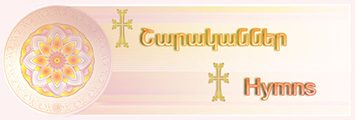Introduction
The origins of the Armenian hymns, or sharakans, can be traced back to the period immediately following the invention of the Armenian alphabet in the early 5th c. A.D. Sts. Sahak, Mesrop Mashtots, and their students Movses Khorenatsi, Gyut Arahezhatsi and Hovhan Mandakuni laid a solid foundation for this form of sacred music and many of the hymns they composed continue to be sung to this day. .
The sharakan form has evolved over the centuries. Nevertheless, it has maintained its essential traits, authentically expressing the Armenian spiritual and artistic soul. Sharakans are also a crystallization of Armenian Church doctrine, which set forth the canons and precepts of the Armenian faith based on the first three Ecumenical Councils.
The etymology of the word sharakan, according to most sources, is tied to the nature and context of the hymn. A sharakan is generally part of a strict sequence or canon of hymns. A sequence or string of items in Armenian is called a shar(k).
In the course of a thousand years, over two thousand sharakans have been composed and canonized. A canon of sharakans is actually a sequence of eight hymns sung in a fixed, logical succession on the occasion of a church feast-day. The system of grouping 8-9 hymn types into a canon was established by 8th-century philosopher-musician Stepanos Siunetsi. He also made for improvements to the modal/melodic classification of the sharakans, also into 8 categories. These eight hymn types have special beginning phrases, which prefigure the subsequent direction of each hymn, and are based principally on the Psalms of David. The canon of the Armenian Church, while sharing traits with the Byzantine canon, evolved into the following structure, each part often referred to in English by the Latin word that begins the verse:
1. Orhnutyun (Blessing Cantemus). "Let us bless the Lord so that he is glorified with glory" (Exodus 15.1).
2. Harts or hartsi sharakan yev Gortsatun (Sharakan of Lord of our Fathers, Patrum). "You are blessed, O Lord of our Fathers" (Daniel 3.52).
3. Medzatsustse (Magnificat). "My soul doth magnify the Lord" (Luke 1.46). Sharakans of this class are dedicated to the Holy Mother of God.
4. Voghormya (Mercy, Miserere). "Have mercy upon me O Lord, according to thy great mercy" (Psalms 51:1).
5. Ter herknits (Heavenly Father, Laudamus). "Praise the Lord from the Heavens, praise him in the heights above" (Psalms 148:1).
6. Mankunk (Children, Pueri). "Bless the Lord, children, and bless his name" (Psalms 113.1).
7. Chashu sharakan (Midday Sharakan). In this case, sections taken from the Psalms are sung, to which the following verses are sometimes added: "I loved that you heard the voice of my prayers" (Psalms 116.1), and "The Lord has reigned, he is robed with majesty" (Psalms 93.1).
8. Hambartsi (I lift my eyes, Levavi). "I will lift my eyes up to the hills; from whence my help will come" (Psalms 121.1).
Orhnutyun is sung during night-time services, Harts, Metsatsustse, Voghormya, Ter Herknits and Mankunk during morning services, and Chashu at meal times. Hambartsi is sung at evening services. At one time, the canon of sharakans was comprised of nine parts, but later the Gortsk or Gortsatun sharakans were incorporated into the Harts sharakan, reducing the total to 8.
The Armenian sharakan is constructed of eight base chants.
Mode I - First Voice (ayb-dza) Mode II - First Antiphon (ayb-ken)
Mode III - Second Voice (ben-dza) Mode IV - Second (Senior) Antiphon (ben-ken)
Mode V - Third Voice (gim-dza) Mode VI - Third (Bold) Antiphon (gim-ken)
Mode VII - Fourth Voice (da-dza) Mode VIII - Fourth (Last) Antiphon (da-ken)
Different versions exist for each of these eight movements. According to Komitas it total there are 64 such variations.
These beautiful sharakans, as well as numerous spiritual songs, verses, and feast-day melodies, were written by church fathers and scholars. Included among them are Sahak Partev (426), Mesrob Mashtots (426), Movses Khorenatsi (441), Hovhan Mandakuni (480), Komitas Aghtsetsi (618), Anania Shirakatsi (661), Sahak Dzoraporetsi (677), Stepanos Siunetsi (735), Hovhan Odznetsi (728), Petros Getadardz (1019), Grigor Magistros (1044), Hakob Vardapet Sanahnetsi (1083), Grigor Pahlavuni (1113), Hovhannes Sarkavag (1117), Nerses Shnorhali (1166), Nerses Lambronatsi (1181), Grigor Skevratsi (1204), Khachatur Vardapet Tarontsi (1205), Vardan Areveltsi (1251), Hakob Klayetsi (1268), Hovhannes Vardapet Pluz (1288), Kirakos Vardapet Yerznkatsi (1478), and others.
These works have adorned the Armenian Church, its religious services and holidays through the centuries, adding a special dimension to the church's spiritual depth and beauty.
This site presents sharakans for the major services and feast of the liturgical year. They include the plainest of Mashtots' hymns, to the most ornate feast-day sharakans, which reflect not only the meaning and mystery of these religious holidays, but also the rich theological traditions of the Armenian Church. This book contains the jewels of the Armenian Church's choral tradition from each of the following categories:
1. hymns from daily hours.
2. hymns for special church rituals and ceremonies, i.e. weddings, baptisms, blessing of water, and feast days.
3. hymns of the Divine Liturgy.
The melodies of the sharakans presented on this site are drawn principally from the Sharaknots (Hymnal) and Zhamagirk (Book of Hours) written in 1878 in Vagharshapat, with preference given to versions that have been handed down orally and have wide currency. There are also short annotations about each sharakan, its author, and the occasions on which it is usually sung.
This site is dedicated first and foremost to our younger generation. We hope that educators in both our public and private educational institutions will be able to sow a love of these centuries' old melodies in the souls of our youth.
